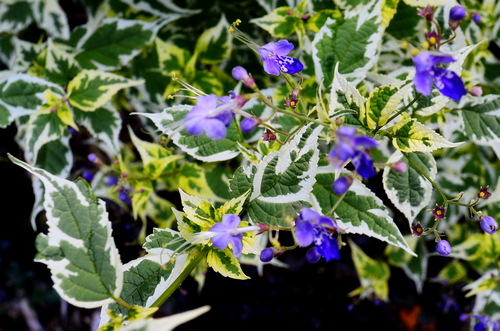Plant of the Month for October, 2020

(kar-ee-OP-ter-iss dy-vair-ih-KAY-tuh)
General Information:
Caryopteris divaricata ‘Snow Fairy’ is an elegant plant that requires almost no maintenance, has few if any pests and looks good most of the year. It should be in every garden that matches its hardiness zone.

Caryopteris divaricata ‘Snow Fairy’:photo by Robert Pavlis
You might know genus Caryopteris as shrubs, but this one is an herbaceous perennial. I have grown it for years and did not know this until I wrote this article. In my zone 5 garden it looks like a shrub that gets killed to the ground in winter, similar to the butterfly bush. It produces very stiff strong stems that keep their shape all year.
It is a bit slow to get going in spring, but by early summer you will have a nice clump of variegated foliage. It keeps growing all summer and never loses its color as so many variegated plants do. There is another cultivar called Caryopteris divaricata 'Blue Butterflies' which has green leaves but much larger flowers. Snow Fairy is a much better choice.

Caryopteris divaricata ‘Snow Fairy’:photo by Robert Pavlis
It does produce flowers in fall most years but due to their small size they really don’t add too much to the plant. You grow this one for foliage. Give it full sun or a bit of shade and don’t worry about watering it; it is quite drought tolerant once established. It will not tolerate a wet site.
The only maintenance I do is to cut it back to the ground in spring. Common names include blue spirea, blue mist shrub, and blue mist spirea.
Since I didn’t know it was a perennial, I took cuttings in midsummer just like my other shrubs and they rooted fairly easily. Spring tip cuttings are reported to work even better.

Caryopteris divaricata ‘Snow Fairy’:photo by Robert Pavlis
Life Cycle: perennial
Height: 100cm (3.5 ft)
Bloom Time: fall
Natural Range: Himalayas (for the species)
Habitat: sunny dry slopes
Synonyms: Tripora divaricata
Cultivation:
Light: full sunto part shade
Soil: well drained
Water: dry
USDA Hardiness Zone: 5- 9
Propagation: division, cuttings
Seedex availability (ORG&HPS annual Seed Exchange): never
